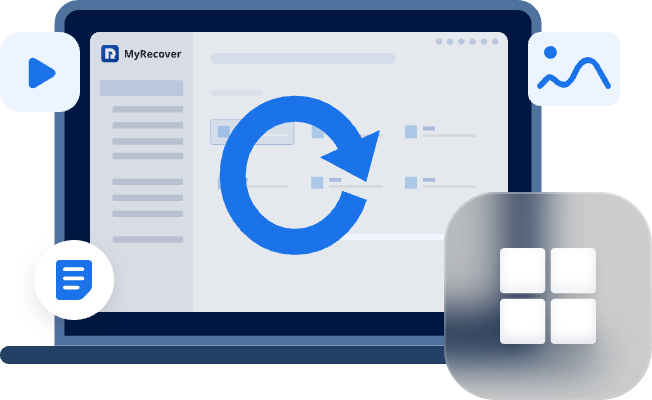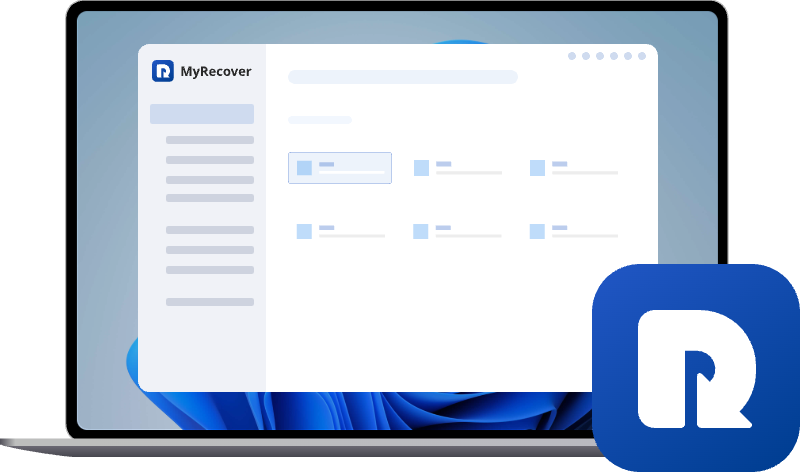Lost Your Visio Work? Here's How to Recover Deleted VSD Now
This guide details proven methods to recover deleted VSD files. We cover manual tricks, professional software, and how to locate the Visio auto recovery file location to restore your unsaved or corrupted diagrams efficiently and quickly.
What is A VSD File?
A VSD file is a drawing file from Microsoft Visio, a diagramming and vector graphics program. It is a proprietary, binary format that contains shapes, text, and other data for creating diagrams like flowcharts and organizational charts. While newer versions of Visio use the XML-based .vsdx format, they still support older VSD files.
VSD files are primarily binary, making them efficient but difficult to access or modify without Visio itself. You can open VSD files via Microsoft Visio or other software like CorelDRAW.
However, you might encounter that you deleted the VSD files by accident. What should you do? Don’t worry, this comprehensive guide is your lifeline, walking you through every possible method, from built-in Windows tricks and Visio's own safety nets to powerful third-party software, to get your valuable work back.
Why Your VSD Files Get Lost?
Data loss can strike in several ways.
⭕ Another common headache is the "unsaved" file. Visio crashes, your computer blue-screens, and the document you spent the last hour on vanishes into thin air because you never got around to saving it.
⭕ Then there's file corruption, where a VSD file becomes damaged and unreadable, often due to saving errors, storage media going bad, or a virus infection.
So, how to recover your VSD files easily?
5 Methods to Recover Deleted VSD Files
So, you've outright deleted a Visio file. Your first move should always be to stay calm and avoid doing anything that could write new data to your hard drive or storage device, as this can overwrite the deleted file, making it much harder to recover deleted VSD files.
Way 1. Check Windows Recycle Bin
The most logical first port of call is the Windows Recycle Bin. It's a simple but often overlooked savior.
1. Double-click the Recycle Bin icon on your desktop, use the search bar at the top to type the name of your VSD file (or just "*.vsd" to see all Visio files).
2. And if you see it, right-click and select "Restore".
3. The file will magically reappear in its original location.
Alas, this only works if you deleted it from within Windows and didn't use Shift+Delete or empty the bin afterward.
Way 2. Recover VSD Files with File History
If the Recycle Bin comes up empty, don't throw in the towel just yet. Windows has another trick up its sleeve: File History. If you had the foresight to set up either of the features, you’re in luck.
1. Search for "Restore Your Files with File History" in the Windows Start menu,
2. Navigate to the folder where your VSD file was stored, and you can browse through previous versions to restore it.
Way 3. Try The Visio AutoRecover Feature
If you have enabled the AutoRecover feature in Visio, you can recover your VSD files easily. The Visio AutoRecover feature can automatically save a snapshot of your work at regular intervals. Check the following steps:
How to recover a file after a Visio crash?
1. Restart Visio after an unexpected closure.
2. The Document Recovery task pane should open automatically.
3. It will display a list of files that were recovered. The most recent version of your file might be listed with "(Recovered)" in the name.
4. You can open a recovered file to view its contents.
5. Once you have recovered your work, you should save it immediately.
Please first check if you have enabled the AutoRecover feature: Go to File > Options > Save. Here, you'll see two critical checkboxes: "Save AutoRecover information every X minutes" and "Keep the last autosaved version if I close without saving". Check both of them. For better protection, set the AutoRecover interval to something frequent, like every 5 or 10 minutes.
Way 4. Manually Recover Your VSD Files
What if the Document Recovery pane doesn't pop up, or you accidentally closed a file without saving? This is a specific scenario that requires a specific hunt. You need to know the Visio auto recovery file location on your machine. This is the hidden folder where Visio stashes those Autorecover files.
1. You can find this path by going to File > Options > Save, and you'll see the "AutoRecover file location" listed. The most common location is something like C:\Users\[YourUsername]\AppData\Roaming\Microsoft\Visio\.
2. You can copy this path and paste it directly into the Windows File Explorer address bar.
3. Once inside, look for files with a .vsd extension or temporary files; they might have odd names, but you can sort by "Date modified" to find the most recent one.
4. Copy this file to a safe location, change its extension to .vsd, and try to open it in Visio.
This manual method is often the key to recovering unsaved Visio file work that seems gone for good.
Way 5. Fast Recover Deleted VSD Files via MyRecover
When manual methods and built-in features fall short, professional data recovery software like MyRecover is your most powerful ally. The application is specifically designed to perform deep, sector-by-sector scans of your storage media to find and reconstruct files that are no longer visible to the operating system.
- MyRecover provides a user-friendly interface that simplifies the recovery process, making it accessible even for non-technical users.
- Its powerful scanning algorithms can locate files based on their signatures, which is crucial for finding specific file types like VSD after they have been permanently deleted.
- You can preview files before recovery to ensure they are intact and the right files you’re looking for.
- Besides, you can select the files you need to recover instead of recovering everything, saving time and space.
We will now explore how to use a tool like MyRecover to recover deleted VSD files with a high success rate.
1. Download MyRecover and install it, then launch it.
2. Tap Deleted Files Recovery, choose the drive where the VSD files were stored before the deletion, and hit Scan.
3. Click OK once it’s completed. All the files are sorted by file type. You can search them by file path, file name, and file size, etc.
4. Preview and choose the files, and hit Recover.
5. You will be prompted to choose a safe location to save these recovered VSD files.
- Tips:✎...
- Once the scan is complete, you can use the filters on the right-hand side to narrow down the results. Filter by "File Type" and select "Document", then look for the VSD extension. You can also use the search bar at the top to type ".vsd".
- You must save the recovered file to a different drive than the one it was lost on to avoid any risk of data overwriting.
- MyRecover Technician is your best choice if you want to recover files from unlimited computers, saving time and cost.

- Recover Deleted Files Easily with Simple Clicks
- 1000+ File Formats Supported
- Support HDD, SSD, External Hard Drive, USB Drive, SD Card, etc.
- Quickly Find Files Using File Types, Name, Size, etc.
- Preview Files Before Recovering
- Recover Unlimited Data
How to Repair a Corrupted Visio File?
A corrupted file is a different beast altogether. It’s there, but Visio throws an error when you try to open it. Fortunately, there are several strategies for how to recover corrupted Visio file data.
Way 1. Open and Repair
First, try Visio's built-in Open and Repair tool. Don't just double-click the file. Instead:
1. Open Visio, go to File > Open, browse to the corrupted VSD file, and click on it once to select it.
2. But then click the small arrow next to the "Open" button.
3. From the dropdown menu, select "Open and Repair".
4. Visio will attempt to fix any structural issues within the file itself.
Way 2. Import to Repair
If that fails, a neat trick is to try and import the diagram into a new, blank Visio file.
1. Create a new drawing.
2. Then go to Insert > Object > Create from file.
3. Browse to your corrupted VSD.
Sometimes, this process can bypass the corruption and bring your content in successfully.
Way 3. Change the File Extension
Another angle of attack is to change the file's extension.
1. Make a copy of the corrupted file and change its extension from .vsd to .zip.
2. Then, try to open this ZIP archive with a program like 7-Zip or WinRAR.
3. If it opens, the corruption might be minor, and you can sometimes extract the XML data within.
This is a more technical last resort, but for incredibly valuable diagrams, it's worth a shot.
Best Practices to Prevent Future VSD Data Loss
As the old saying goes, an ounce of prevention is worth a pound of cure. After you've successfully navigated the recovery process, it's time to build habits that will keep you from this stressful situation again.
- First and foremost, become a compulsive saver. Hammer that Ctrl+S key every few minutes.
- Secondly, configure your Visio Autorecover settings to save information every 5 minutes, as mentioned earlier.
- Third, implement a robust backup strategy. Use an external hard drive with File History or a cloud storage service like OneDrive or Google Drive, which often keep version history, allowing you to roll back to a previous version of a file.
- Finally, be mindful when deleting files and always double-check the contents of the Recycle Bin before emptying it.
FAQs About Recovering Deleted VSD Files
Can I recover a VSD file after emptying the Recycle Bin?
A: Yes. Emptying the Recycle Bin doesn't erase the file immediately—it just marks the space as available. Using recovery software like MyRecover before new data overwrites it can successfully restore your VSD file.
What is the difference between Autorecover and AutoSave in Visio?
A: Autorecover saves temporary copies locally to protect against crashes, while AutoSave automatically syncs changes to cloud-based files on OneDrive or SharePoint in near real-time.
Why can't I open my Visio file, and how can I fix it?
A: This is usually due to file corruption. Try using Visio's "Open and Repair" feature first. If that fails, test the file on another computer or run Visio in Safe Mode to check for add-in conflicts.
How do I find unsaved Visio files after a crash?
A: Check the Document Recovery pane when restarting Visio. If it doesn't appear, manually navigate to the Visio auto recovery file location (found in File > Options > Save) to look for temporary VSD files.
Is it possible to recover a VSD file from a formatted hard drive?
A: Yes, if it were a quick format. This only erases the file index, leaving data recoverable with tools like MyRecover. A full format, however, makes recovery nearly impossible.
What should I do if my VSD file is corrupted and won't open?
A: Start with Visio's "Open and Repair" feature. If unsuccessful, try inserting the corrupted file as an object into a new Visio document or opening it in a previous Visio version. For critical files, consider professional repair services.


